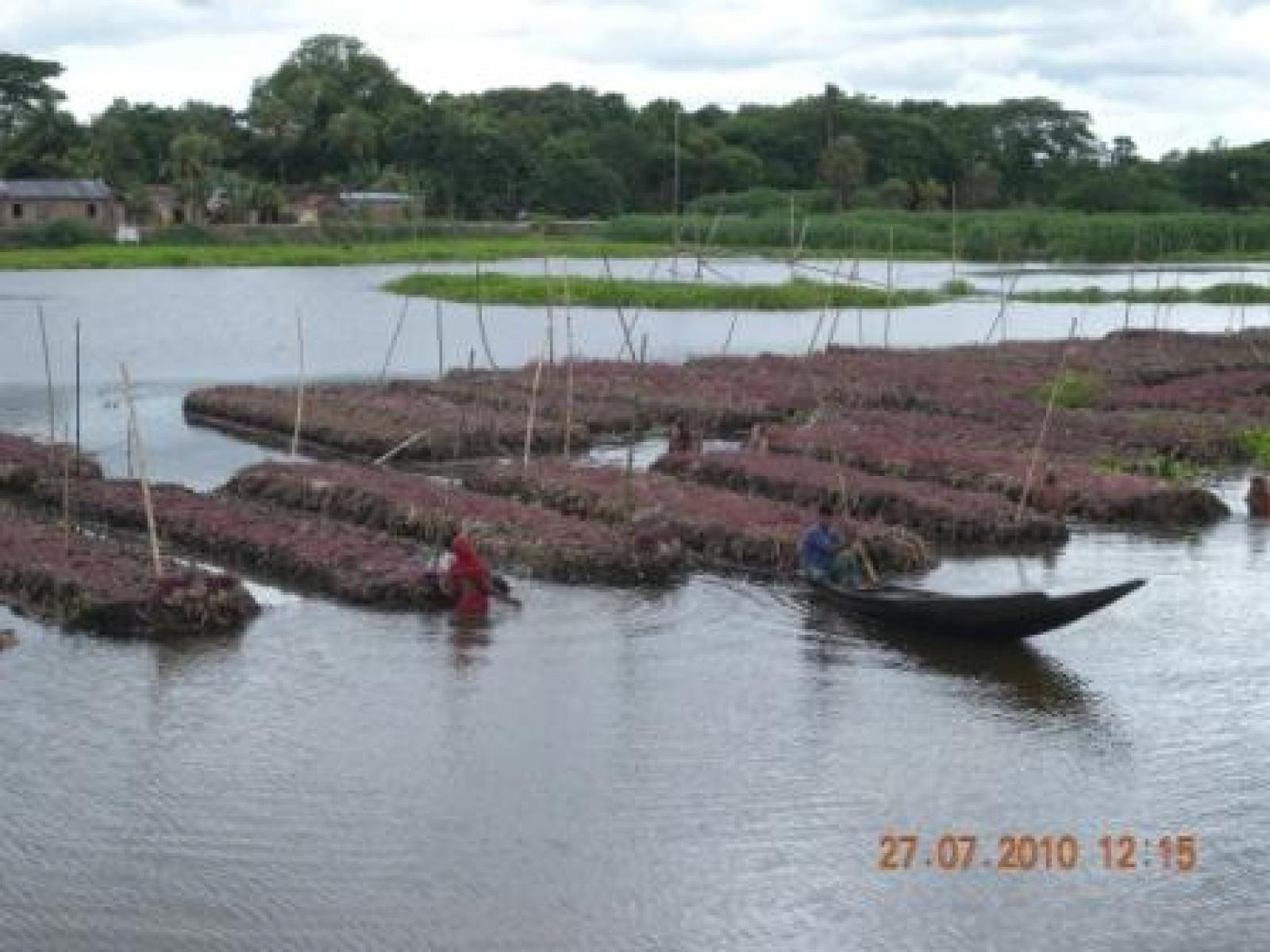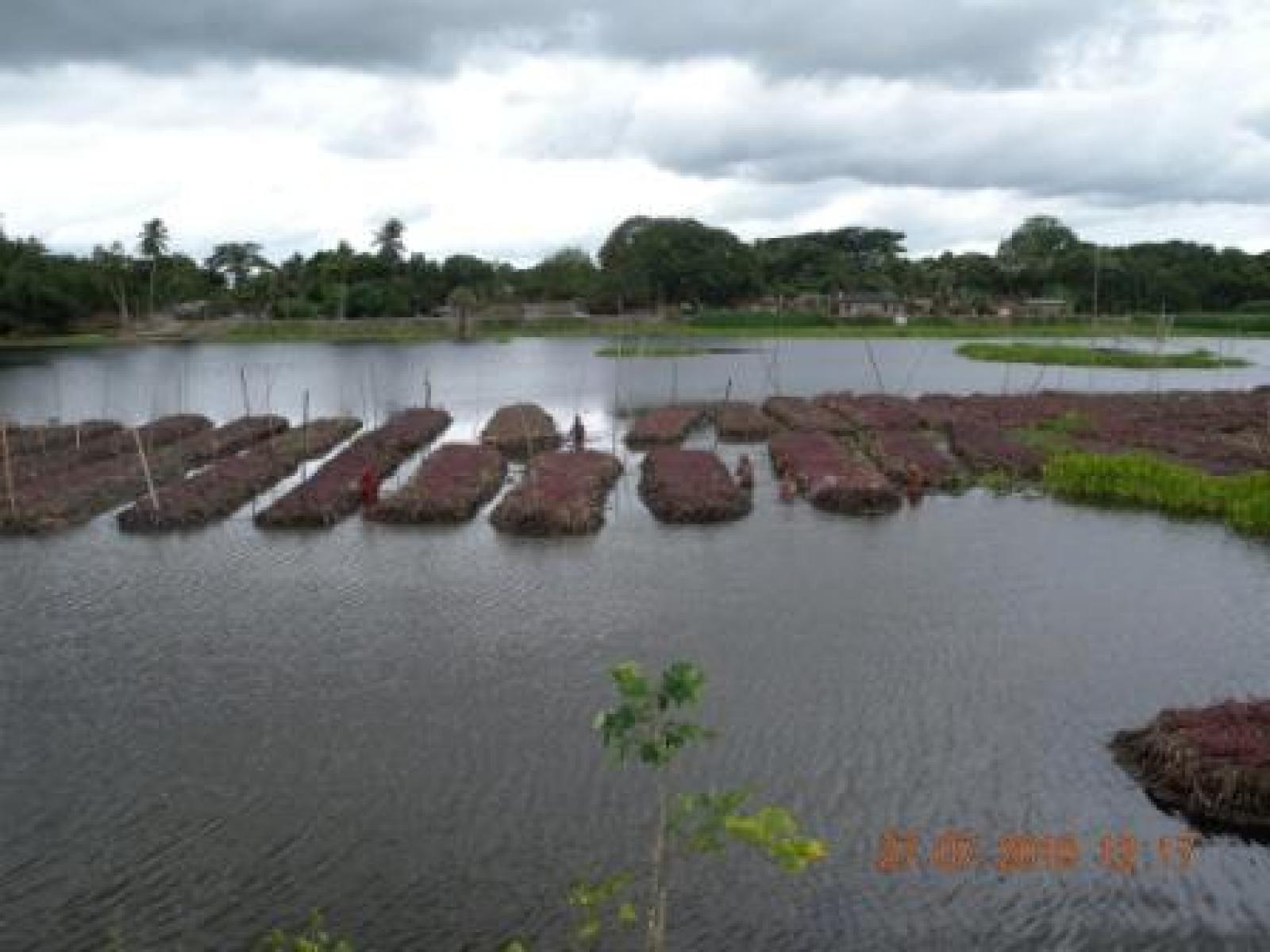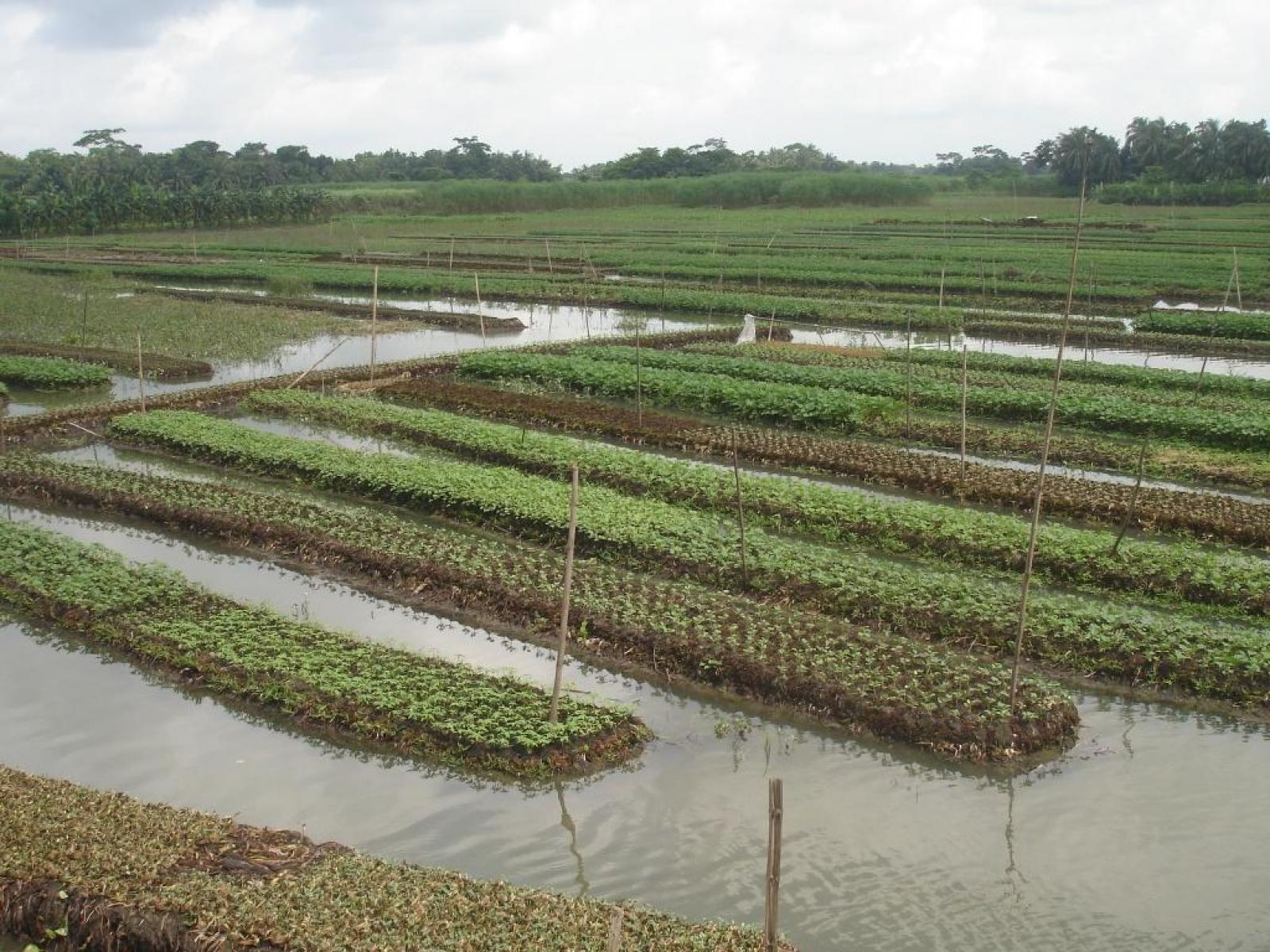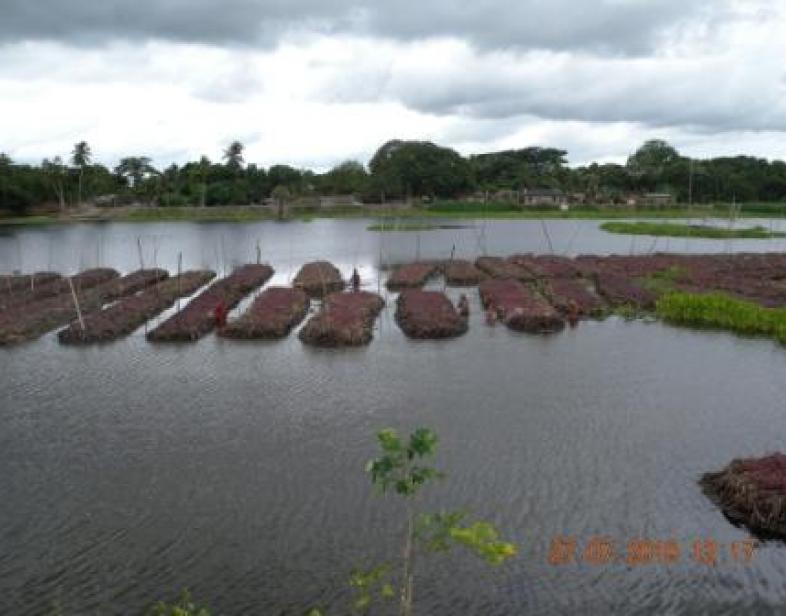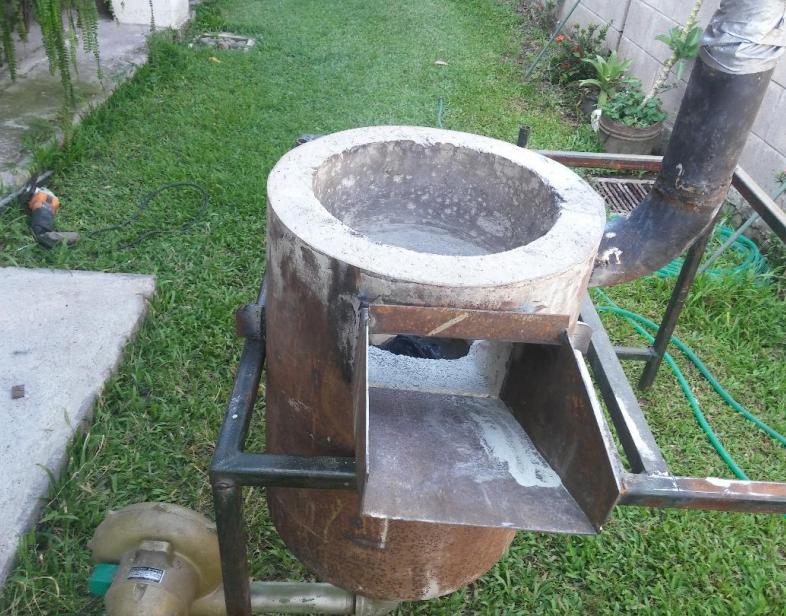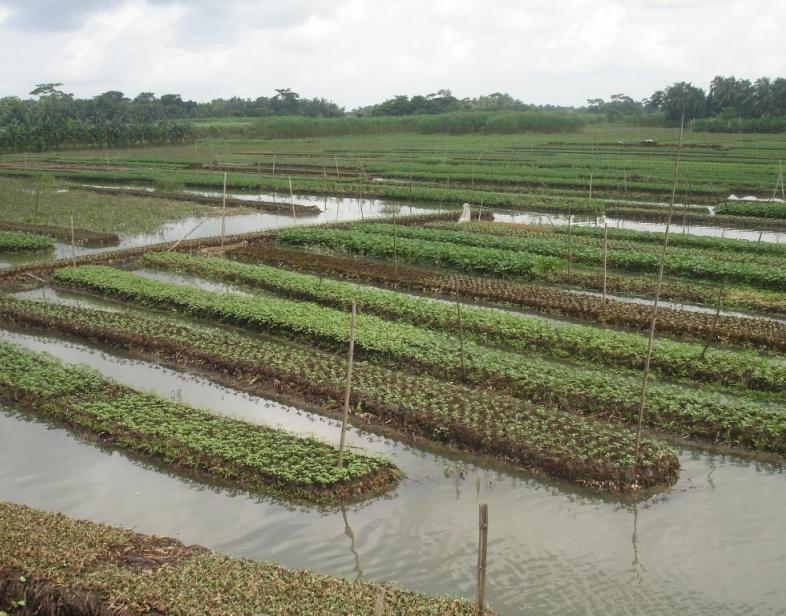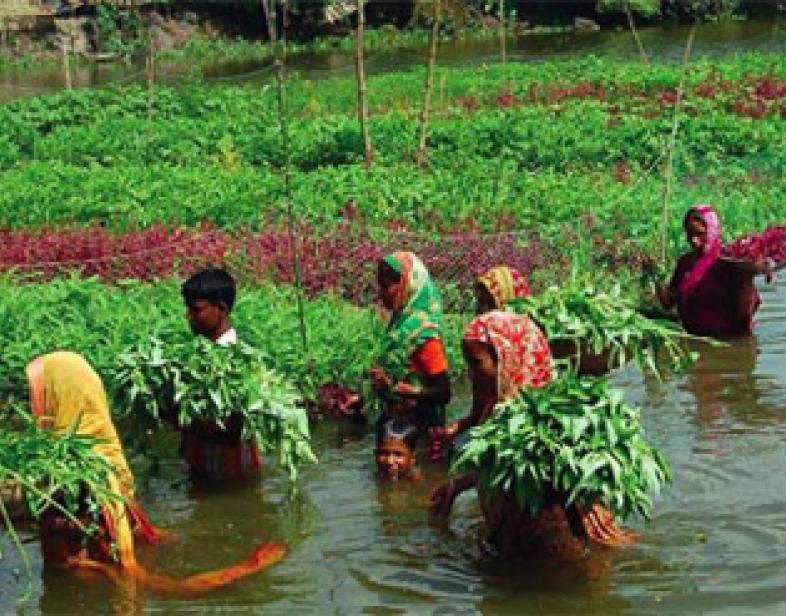An Overview Of Our Solution
In many suburban and rural areas, women in Bangladesh are not allowed to perform any outdoor activities. The social & religious norms; the attitude from the elder members always restrict women to participate in the labor force. The cultural & social outlooks pressed them to stay inside the household. But this scenario is changing in south-west coastal region of Bangladesh which is the hotspot affected zone regarding climate change where millions of people are affected by medium-term (4-5 months) waterlogging. Women in this region are coming outside and taking part in soilless agriculture. Using the local water hyacinths or other raw materials, they are preparing floating beds in the waterlogged area where several crops can be produced. Often male members are migrating to big cities for work and women have no other choice rather than doing this soilless farming.
- Population Impacted: 1500,000
- Continent: Asia
Context Analysis
The beauty of the project was its temperament to deal with hot climatically affected regions securing the objective of extreme poverty reduction and hunger. Heavier than usual rains and the natural waterflow disrupted by Coastal Embankment Project resulted in flooding in south-western districts of Bangladesh. The rivers have become silted up. The flood waters have not significantly receded with some unions remaining inundated with water. Every year waterlogged area is expanding at the rate of 5070 hectares. Soilless agriculture needs no irrigation and won’t require the land to be transformed into dry land, saves energy, conserves wetlands and wetland biodiversity and instead of emitting CO2, rather helps to Carbon Sequestration. Its products are fully organic containing high nutritious value and can be produced at off-season. The productivity of this farming system is 3-7 times higher than traditional land-based agricultural production.
Describe the technical solution you wanted the target audience to adopt
The soil-less cultivation system originated in Gopalgonj, Pirojpur and Barisal districts. Cultivation procedures are not identical. Farmers developed their own techniques according to their experience, choice, demand and supply of crops in season. The size and shape of the bed is not fixed. Farmers make the bed as they feel appropriate. Generally, the dimension of the bed is 30-40 ft. long, 3-5 ft. width and 3-4 ft. height. The depth of the water bodies is not so significant for preparation of bed. It can be managed in any depth of water. The floating bed whether made by paddy stub or water hyacinth are used to cultivate different kinds of vegetables and saplings. Sometimes farmer use aquatic semi-decomposed plants and immature small water hyacinth on the top of the bed due to decompose the top of the bed quickly, make available nutrient for seedlings and make an ideal ground for settling germinated seeds and different crops. The top needs 15-20 days to be totally decomposed.
Type of intervention
Describe your behavioral intervention
In Bangladesh, now thousands are engaged with floating garden seasonally, but 2 million poor farmers can be engaged with floating garden immediately (Khan et. al, 1994). Wetlands are estimated to occupy nearly 6.4% of the Earth’s land surface. Nearly 30% is made up of bogs, 26% fens, 20% swamps and 15% flood plains (Limgis, 2001). The amount of fresh water on earth is very small (covering 2.53% of the earth’s water) compared to seawater. Presently, a total area of 111 million hectares where soil-less agriculture can be promoted (European Space Agency, 2003).
This farming system is labor intensive but not too strenuous, so women can easily participate in this farming system. Women engagement in this farming system has multiple benefits:
Women involvement in the labour force thus avoid those social, religious and cultural barriers.
Soilless agriculture has greater flexibility to work (don’t need to travel long) so women can perform this work beside their household activities.
During waterlogging, there is no earning opportunity in that area, so women involvement can contribute to the economic empowerment of those poor families as well as to the economic growth of the country.
Restricting women engagement in outdoor activities has multidimensional deficits e.g. absence in educational attainment, absence in decision making etc. So, this behavioural change which is context specific but has multi-dimensional benefits in terms of total context of the country.
As needed, please explain the type of intervention in more detail
Women empowerment is one of the important aspects in the third world countries like Bangladesh. It is not possible to touch the desired plinth if women don’t come outside and perform the economic activities.
Furthermore, the flood and waterlogging situation in Bangladesh is worsening gradually due to the impact of the climate change. In this situation, if the behaviour of women or the social attitude towards women doesn’t change then these affected families need to suffer more. So, considering the context and time, it is the perfect opportunity to come outside and perform the adaptation activities. This change can create an example and assist the women from other areas to do outdoor activities.
Describe your implementation
To implement this activity, the society need two-fold assistance-
Capacity building of women on technical issue (training regarding floating agriculture) and
Awareness raising inside the society that they can break the cultural and religious barriers
Normally engaging women in these outdoor activities is not an easy task. The project has created small groups inside the community. These groups participated in regular meeting to have awareness sessions and have capacity building trainings.
Technical capacity building includes seedling production in soilless agriculture. It is very much attractive and profitable for farmer as in this system seedlings are not damaged by heavy rain or droughts. The most suitable way to prepare the seedlings in floating beds is making Tema (A ball made of compost manure and aquatic creepers in which seeds are inserted for safety of germination). Generally, women can easily involve with this Tema preparation and can be done in the homestead space. During these six months, seedlings can be harvested ten times from a bed and each time about 1500 to 3500 seedlings can be raised depending on species. Women receive regular technical assistance in this issue. Vegetables are the main crops usually cultivated in this system. A large variety of vegetables are also cultivated on floating beds. Usually all types of vegetables are possible to produce in the floating agriculture system. Women receive also regular training regarding this issue.
These group-based activities help women to break the mythology. The best practices are awarded, and they learn from each-other. Being a group, it is easier to stimulate the social empowerment. Today, almost 2000 women are involved with this farming system. At the beginning, there were some concerns from male members. But the situation became better after having those awareness sessions.
External connections
Civil society is the main partner in this project. There are several national and international aid organizations who are working behind these capacity and awareness building trainings.
Local champions are playing key roles here. Local Imam, school teachers are performing as role models. They are also involved in several trainings.
Local print and TV media are regularly showcasing their success factors which are very encouraging for them.
Local elected leaders are connecting them with different safety-net projects.
Local public offices like agriculture office, livestock office are also facilitating different trainings.
Who adopted the desired behaviors and to what degree?
The project has worked with poor female households who is not the member of micro-finance institutions, have no productive land and household daily income is not more than 22 BDT/person (0.3 USD). As these women are extreme poor, so they don’t have access to education. In the waterlogged area, almost 20% (around 2000) women have already been engaged with the floating agriculture activities.
Some women who came from highly religious and fundamentalist background, don’t want to come in front of the external people. But continuous awareness and motivation sessions are gradually breaking their cultural mythology. It needs continuous sessions to bring them out fully.
How did you impact natural resource use and greenhouse gas emissions?
Indigenous soil-less agricultural system can be called hydroponics. This system also fulfils the criteria of “Organoponics” as semi-decomposed plant materials are used for nutrient solution. So, Indigenous floating agriculture is a combination and can be defined as “Organo-hydroponics” (Haq et. al, 2002).
The people living within the wetland ecosystem utilize locally available paddy stubs, water hyacinths and various aquatic plants for making the floating bed. Farmers collect water hyacinths from the nearby wetlands where it grows profusely. They use also semi decomposed aquatic weeds or Pistia stratiotes, Najas graminea, etc., on top of the floating bed to grow vegetables and saplings. Normally these plants are found in local wetlands. (Wolverton, 1976, pp. 21-25). Other ingredients commonly used for this cultivation are Bamboo and coconut husk, are collected from local sources. So, this farming system is fully based on natural resource and has great carbon sequestration power.
What were some of the resulting co-benefits?
The health status of the beneficiaries has been improved largely. At the beginning, their health status was -0.007 in the scale of -2 to +2. But now the monitoring system shows that they are in +1.009 (CMS Report, 2015).
The confidence of women was only at 0.831 in the scale of -2 to +2. But now this is 1.2777 (CMS Report, 2015). According to the report, their socio-economic status has improved significantly, and they are now empowered.
Their expenditure went from 0.112 to 0.572 in the scale of -2 to +2 during last 6 months (CMS Report, 2015). 91.9% women (surveyed 121 women) said that they have some sort of savings now after the project. They have also built up several household assets (mostly the household items) after receiving earning from the project intervention.
At least 21% of women have received access towards the social safety-net programs (endline survey, 2015). All the women received technical training and child and WATSAN related awareness tips from the project.
Sustainability
Women would like to continue their farming after the project. They have established a daily routine with the farming system and will continue their group meetings to collectively discuss problems and find solutions.
Their regular income will continue as the sound marketing linkage has also been developed. Security has also been a major issue throughout the project, particularly regarding land and water grabbing. But as the public departments are helping and they have established a good relationship with local elected leaders, so they will not face any difficulty to access the water bodies. All the BHHs have significant savings now so they will be able to continue their interventions. This will also reduce the numbers of seasonal migration.
Return on investment
For preparing 5 floating beds, it is needed around 4,500 BDT (53.06 USD) and it is possible to earn 15,280 BDT (180.18 USD) from these beds depending on production type. Women engagement in this production system doesn’t cost anything extra. Importantly, they have no other feasible alternative at that period (adaptation to waterlogging). Women engagement needs only some extra awareness or motivation sessions (can be conducted by the volunteers).
Results compared to the investment is huge. The social and cultural barriers are disappearing. Almost 2000 women have already been engaged with the intervention. Total 61 women were randomly surveyed, and their expenditure has increased from 1165.02 BDT to 8682.88 BDT (evaluation report, 2015).
How could we successfully replicate this solution elsewhere?
Initially, the project has worked with 1000 poor households (around 2000 women) in Keshabpur and Tala subdistricts.
Activities can be replicated in Bamna, Bhandaria, Khawkhali, Mathbaria, Nazirpur, Pirajpur, Nesarabad, Manirampur, Jhikarghaca subdistricts of Jessore, Satkhira and Barguna Districts. Total 750,000 women can be involved from the s-w coast (evaluation report, 2015).
If the project works with the bottom part of the society, the initial investment cost is needed. For 750,000 women, it needs around 400 Crore BDT (4.73 crore USD-5 floating beds/woman). But the intervention can be taken at lower scale.
The target group needs regular training and awareness sessions. Local organizations can play role in that regard. The cost of these trainings is minimal, but it is necessary to do a rapport building with public offices, local champions and other stakeholders.The demand for organic products is high. But it is needed to establish connection with national/international market.
